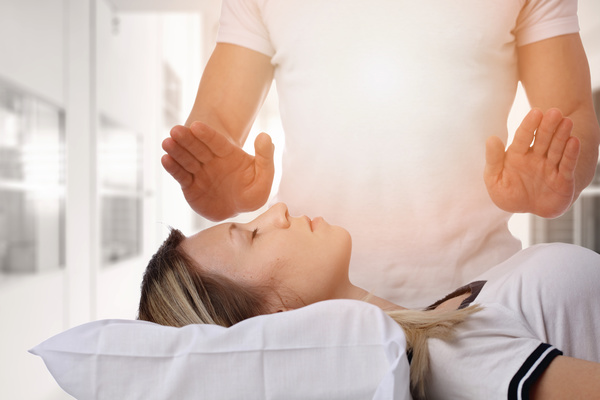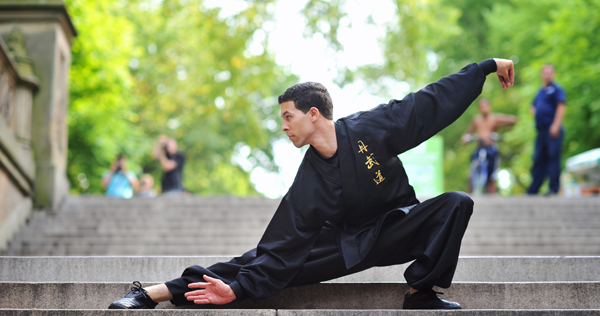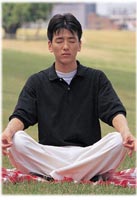Types of Qigong:
There are many forms and styles of Qigong, but they all fit into one of three main categories:
- Medical Qigong to heal self and others
- Martial Qigong for physical prowess
- Spiritual Qigong for enlightenment
- Taoist Qigong
Generally, all Qigong practitioners incorporate exercises and techniques from all four categories–the only difference is their focus.
Taoist Qigong:
- Taoist Qigong was China’s first qigong method, from which all other branches of qigong derived their techniques. In ancient China, Taoist meditation adepts from the Water tradition passed down through Lao Tse developed their inner awareness of chi flows.
- They directly perceived how to work with energy to maintain superior health, heal illness and realize profound inner stillness and spirituality.
- These adepts began to create and systematize qigong, the foundation for traditional Chinese medicine, acupuncture, self-healing energy work, tai chi and therapeutic qigong bodywork (qigong tuina).
- Taoist qigong from the original Water tradition is based on softness and is valued for its
ability to regenerate the body. As you move into middle age and beyond, the
techniques can enable you to feel and function as if you were still in your
twenties or thirties. - Taoist qigong works with your physical motions and energetic systems and the way in which they precisely affect specific parts of the body.
- This includes the muscles,connective tissues (ligaments, fasciae, tendons), bones, joints, fluids,
nerves, internal organs and glands, as well as all the energy channels, points
and centers (tantiens) and mind states. - The ability to become aware of and control the flow of chi is codified in the sixteen neigong components.
- These components are the foundation for some or all of the
techniques of every major qigong system in China. Each physical and energetic component of neigong includes many different techniques and permutations. - Hundreds of Taoist qigong forms exist. These practices allow people to control the movement of their own life force, first through physical movements that increase chi.
Advanced techniques use the mind alone to direct the flow of chi. - The neigongcomponents help open the mind and calm the heart by emphasizing inner stillness, emptiness, letting go, softness and relaxation.
- Although its work can be subtly intense, the trademarks of Taoist qigong in its purest form.
- Tai chi and other internal martial arts practices, some of which were not fully developed until the nineteenth century, fall within the definition of Taoist qigong
because they are based on neigong. - In general, you can expect to attain similar health and relaxation benefits from practicing any Taoist internal martial art.
- However, most Taoist qigong can be done without needing to engage in
self-defense practices.
Buddhist Qigong:
- Buddhist qigong originated from India’s Hatha yoga and pranayama (breath and energy control) tradition.
- It traveled into China through two main sources. First, it came to the Shaolin Temple (home of kung fu) in central China, where it was taught to Buddhist monks to make their bodies strong enough to withstand prolonged meditation sessions and stay healthy.
- The second source of Buddhist qigong is the Tantric tradition of Tibet, from where it spread throughout western China and moved eastward. Buddhist qigong’s trademarks tend to be hard, sometimes jerky and often linear movements.
- There may be forceful physical and energetic expression as well as strain, overt physicalexertion and muscular tension.
- Stretching may often be accomplished throughforce of will instead of internal release.
- Buddhist qigong practitioners mayhold their breath, shout and use explosive exhales.
- First they may releasetremendous amounts of energy, sometimes in a very cathartic manner, to opentheir minds and expel embedded aggression and negative emotions.
- These releasesthen may be followed by deep relaxation and internal experiences of stillness.
- Over time, Taoist and Buddhist qigong practices influenced each other and led to manyoffshoots.
- For example, in the Shaolin Temple, where people from the Chan (ZenBuddhist) and Taoist kung fu traditions met, Zen adopted many Taoist influences. Similarly, in the twelfth century, many of the qigong methods of Tibetan Buddhism, especially those that used copious visualizations and soundvibration techniques, found their way into the Taoist chi practices of theneo-Taoist (Fire) tradition.
- The Fire method was developed about 1,500 years after the original Taoist Water tradition.
- The next three types of qigong borrow specific techniques from both Taoist and Buddhist qigongand focus on specific functions and benefits.
Medical Qigong
- This is the most popular of the three categories.
- It is the oldest of the four branches of Traditional Chinese Medicine and the energetic foundation from which acupuncture, herbal medicine, and Chinese massage (tui na) originated.

- Woman having reiki healing treatment , alternative medicine concept.
Thus Qigong shares the foundational theories of Traditional Chinese Medicine and uses similar diagnostic and treatment methods.
There are two types of medical Qigong:
- Self-Healing Qigong, during which individuals practice Qigong exercises to enhance their health, prevent disease, and address illness.
- External Qigong or Qi Emission, during which Qigong practitioners emit Qi with the intention to heal others. (See more about this below.) In addition to emitting Qi for healing, a good Qigong practitioner usually prescribes specific exercises designed to help regulate Qi. The patients incorporate these Qigong exercises into their daily practice as well as receive occasional sessions from the Qigong healer/practitioner.
Martial Qigong
- This type of Qigong focuses on physical prowess. Martial Qigong practitioners can break bricks, bend steel wires, place sharp objects in vulnerable parts of the body without damaging the skin, or sustain physical impact from baseball bats. Martial Qigong practitioners can demonstrate physical feats considered impossible by modern science.

Spiritual Qigong:
- This type of qigong uses mantras, mudras (hand positions), sitting meditations, and prayers to pursue enlightenment.
- These techniques are heavily influenced by Buddhism, Taoism, and Confucianism.
- Spiritual Qigong teaches discipline and leads to self-awareness, tranquility, and harmony with nature and self.
- Spiritual practitioners train their Qi to a much deeper level, working with many internal functions of the body.
- They practice to obtain control of their body, mind, and spirit, with the goal of escaping from the cycle of reincarnation.
